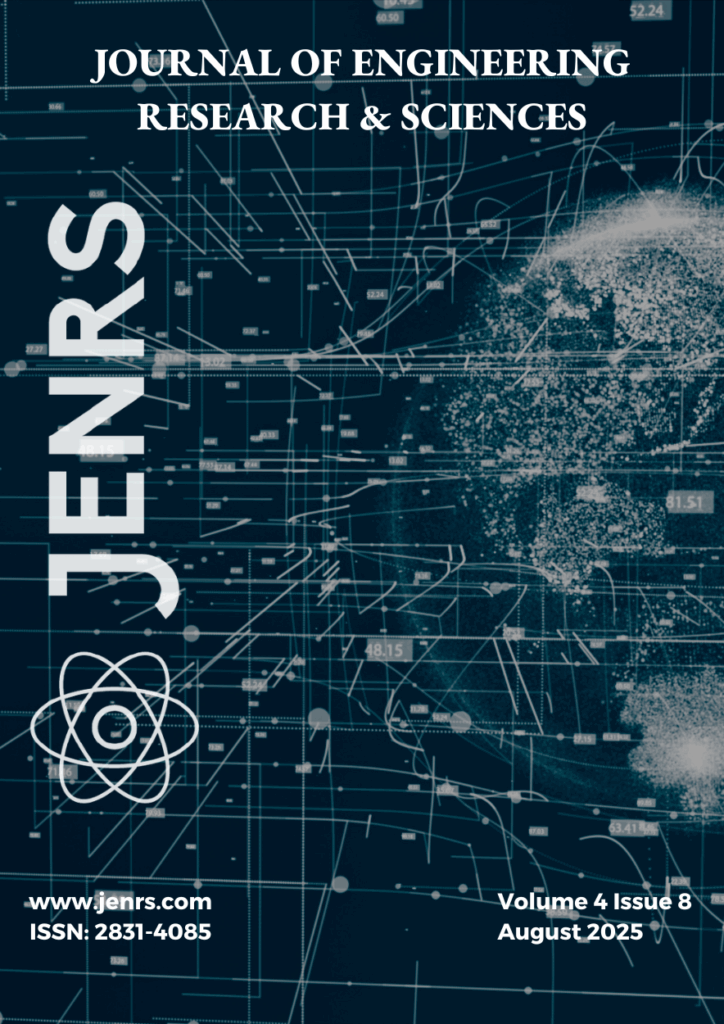Volume 4, Issue 8 (August 2025) - 5 Articles

This issue presents five studies that deliver practical advances and clear trade offs across these areas. A review of US green tariff programs finds they enabled significant renewable capacity but remain constrained by regulatory limits and program scale. An AI-augmented cybersecurity framework improves compliance detection and speeds recovery. A quantum-inspired genetic algorithm enhances optimization for hard software problems. A magnetic AI agent offers lightweight, audience-focused explanations for opaque models. Finally, AI decision support embedded in SAP workflows strengthens purchase order compliance in life sciences. Together, the papers point to transparent, resilient, and sustainable systems.
Journal of Engineering Research and Sciences, Volume 4, Issue 8, Page # i-i, 2025
Journal of Engineering Research and Sciences, Volume 4, Issue 8, Page # ii-iii, 2025
by Jinhua Xiao
Journal of Engineering Research and Sciences, Volume 4, Issue 8, Page # iv-v, 2025
Journal of Engineering Research and Sciences, Volume 4, Issue 8, Page # vi-vi, 2025
by Sahil Shah
Journal of Engineering Research and Sciences, Volume 4, Issue 8, Page # 1-17, 2025; DOI: 10.55708/js0408001
Abstract: This paper provides a comprehensive review of green tariff programs in the United States from 2013 to 2025, examining their role as market accelerators for corporate renewable energy adoption and their impact on commercial and industrial (C&I) decarbonization strategies. Green tariffs represent voluntary utility programs that enable large energy customers to procure renewable electricity directly through their serving utility, offering an alternative…Read More
(This article belongs to Environmental Sciences and Engineering: Green and Sustainable Science & Technology (GSS))
by Harshavardhan Malla
Journal of Engineering Research and Sciences, Volume 4, Issue 8, Page # 18-23, 2025; DOI: 10.55708/js0408002
Abstract: Public sector IT infrastructures that underpin essential services, such as transportation and law enforcement, are becoming progressively susceptible to advanced cyber attacks and encounter heightened regulatory demands, especially in accordance with CJIS and NIST standards. Regrettably, existing methods for compliance enforcement and patch management are primarily manual or only slightly automated, thereby constraining their scalability, precision, and adaptability… Read More
(This article belongs to Computer Science and Information Technology: Information Systems – Computer Science (ISC))
by Hager Hussein
Journal of Engineering Research and Sciences, Volume 4, Issue 8, Page # 24-30, 2025; DOI: 10.55708/js0408003
Abstract: Software engineering plays an important role in computer science. Novel quantum algorithms can efficiently solve software-engineering problems. Not only software engineering but also many industries including logistics, finance, genomics, resource allocation, logistics, bioinformatics, mobile agents and more have optimization problems. Such problems may have long time solutions. Research has been conducted to improve the performance… Read More
(This article belongs to Mathematics and Physics: Quantum Science and Technology (QST))
by Maikel Leon
Journal of Engineering Research and Sciences, Volume 4, Issue 8, Page # 31-40, 2025; DOI: 10.55708/js0408004
Abstract: Artificial intelligence already influences credit allocation, medical diagnosis, and staff recruitment, yet most deployed models remain opaque to decision makers, regulators, and the citizens they affect. A new wave of transparency mandates across multiple jurisdictions will soon require organizations to justify automated decisions without disrupting tightly coupled production pipelines that have evolved over the years. We advance a conceptual proposal to address… Read More
(This article belongs to the Special Issue on Multidisciplinary Sciences and Advanced Technology (SI-MSAT 2025) & Section Computer Science and Information Technology: Artificial Intelligence – Computer Science (AIC))
by Vinil Apelagunta and Vishnuvardhan Reddy Tatavandla
Journal of Engineering Research and Sciences, Volume 4, Issue 8, Page # 41-49, 2025; DOI: 10.55708/js0408005
Abstract: Resilient and compliant supply chains, while essential to the Life Sciences, depend heavily upon SAP systems to manage the complexities involved. The standard Purchase Order (PO) approval process in SAP is an important upstream control point in the supply chain, but seldom has the required intelligence needed to manage endorsed compliance (e.g., GxP) or to be proactive in supply chain risk mitigation… Read More
(This article belongs to the Section Computer Science and Information Technology: Artificial Intelligence – Computer Science (AIC))
